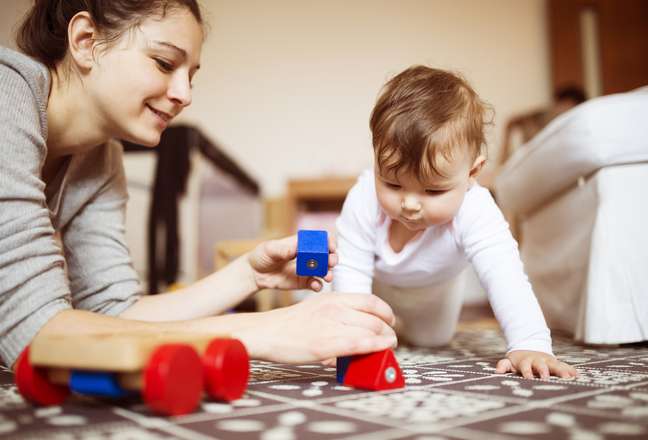Is technology in childhood always harmful? Should I compare my child with his friends? Check out the answers to these and other questions!
Everyone knows that every child has their own pace for learning to talk, walk, get out of the diaper… It is natural, however, for parents to worry if the child is reaching developmental milestones and look for ways to stimulate their abilities. But it is good to remember not everything that is said about early life learning is real. Find out below the main myths and truths on the subject and see some tips to use with your child.

1. The stimuli should begin during pregnancy
TRUTH. Still inside the uterus, the baby can already hear – albeit in a muffled way – sounds coming from outside. Her hearing aid starts forming from week 18, but it is around week 24 that sounds are clearest.
” From 6 months of pregnancy, interacting through conversation or reading aloud helps. The child is born with a curiosity and a natural aptitude for learning and experiencing the world “, explains the specialist in Neuroscience and Child Development Ane Macedo, of Projeto Pigmeu. Different areas of life”, he adds. It is therefore a process that begins in pregnancy and continues in the following formative years.
2. There is a “right time” and exact for each skill
MYTH. “Every child has his time and it is important to respect it”, warns the specialist. Furthermore, everyone can develop different skills at different rates and times. Confrontation with close friends or close relatives is unhealthy as it can lead to the feeling that your child is “late”, generating anxiety in the parents and even the child, who can feel this pressure.
There are indeed developmental delays, but if there is any suspicion, the right thing is to talk to the pediatrician so that he can evaluate and give the necessary indications.
3. I can encourage my child to start talking
TRUTH. Ane Macedo says that talking to little ones certainly contributes to learning the word. You can tell a story, comment on something about your day or even points to objects and pronounces their names. When the child starts speaking, remember to encourage rather than correct.
According to the neuroscience specialist, making negative comments, such as saying you can’t understand anything the child is saying, can be very disheartening. The interesting thing at this stage is just the opposite: encourage her to talk more and more without interrupting her to point out the mistakes.

4. The use of technology is always negative
MYTH. In an ideal world, the Brazilian Association of Pediatrics advises against the use of a network until the age of two and, from two to five, only one hour a day. But we know in the real world, technological resources end up being great allies for families day to day. Taking this into account, even more so after a long time of pandemic, the ideal is that it is a conscious use. “What can make the interaction between technology and humans harmful is the dosage,” said Ane Macedo.
The advice here is not to allow indiscriminate use of the TV or tablet, for example, but establish screen time that makes sense for the child’s age . In addition, there are programs and applications for educational purposes and which also stimulate some skills.
“Use the screens, but use them wisely. One strategy is to opt for video or language games with the childshowing you how to articulate the words, or choosing a small game or dance video to make her move with you, encouraging motor development and social disinhibition, “she adds.
5. The stimuli must have a limit in order not to be excessive
TRUTH. According to Ane, this excess can generate a mental overload. “Children need recreation and entertainment, in addition to creative free time, which is important for semantic memory processing and mental reorganization,” he explains.
In other words, don’t worry about filling your child’s entire agenda with extracurricular activities while thinking about their development, after all, the time to “do nothing” also counts. – it’s a lot! – in that process. As always, balance is everything.
6. I cannot stimulate my child without many resources and toys
MYTH. To help the little ones, No It is not necessary to have many resources, as long as they are the right ones . This does not necessarily imply material things. You don’t have to buy the most expensive Montessori toy in the store to help your child train fine motor skills, or buy the plush puppy that speaks in two languages, sings and even pretends.
Seemingly simple attitudes, such as talking to the child , stimulate her curiosity with the objects of her own home, dance and let her explore things and environments (of course, as long as it’s safe), already make a difference. It is also worth mentioning that there are a number of activities you can create using the materials you have out there.
Remember that in the first years of life, every situation is a new possibility of discovery and learning for that little being who begins to see himself in the world.
Source: Terra
Benjamin Smith is a fashion journalist and author at Gossipify, known for his coverage of the latest fashion trends and industry insights. He writes about clothing, shoes, accessories, and runway shows, providing in-depth analysis and unique perspectives. He’s respected for his ability to spot emerging designers and trends, and for providing practical fashion advice to readers.




![Such a wonderful sun in advance: August 13, 2025, Summary of Wednesday Episode [SPOILERS] Such a wonderful sun in advance: August 13, 2025, Summary of Wednesday Episode [SPOILERS]](https://fr.web.img3.acsta.net/img/0e/66/0e66cd7c43df61060be104979eb3e539.jpg)


